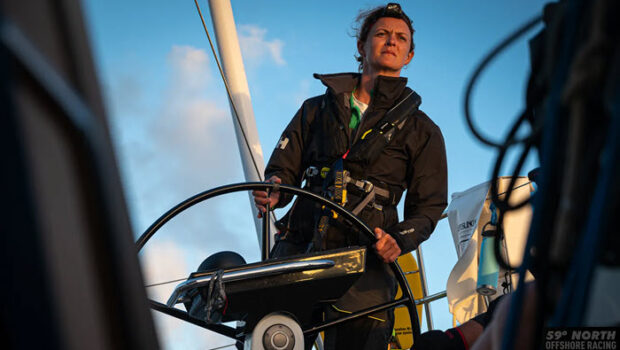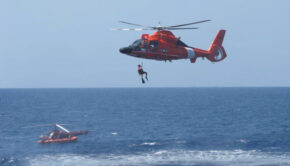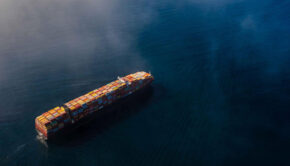In sailing, safety still isn’t ‘cool’
Published on April 27th, 2025
by Nikki Henderson
When skippering, I check my safety calls by asking myself, “If I had to stand up in court, could I justify my choices / actions?”
It works, mostly. Except, sailing is inherently risky. And, I’ve always wondered – would I be ever be able to fully justify leaving the safety of shore? So is anything that happens at sea actually justifiable? At some point, I decided to leave the dock and sail towards danger. Could I defend that choice?
Risk is confusing. Driving on the highway. Eating meat. Bending over to put your socks on in the morning. Climbing the stairs. Drinking alcohol… Everything is in some way risky. So to live at all, we have to set a ‘minimum risk tolerance’. What is ‘too risky’ and ‘not very risky’ is different for everyone. And for everyone, it changes regularly. It’s relative to experience.
Let’s take lifejackets. I could tell you that going to sea and not wearing a life-jacket is risky and not justifiable. But I could also admit that I have made choices to not wear a lifejacket plenty of times. I justified it:
• It was warm water and I can swim.
• We were always in sight of the shore, and if I fell in I was confident we could swim.
• I have sea legs and it’s very unlikely I would ever fall in.
• My agility is limited when I wear life-jackets, so I chose not to wear one.
I’ve also use these justifications to defend my choice to not enforce my crew to wear lifejackets. Like the other day in the Caribbean. I went out on a day’s training with an amateur crew and I didn’t make them wear one. It felt justifiable at the time. Well … sort of. After that day, I reverted back to “best practice” and they wore them every day.
Seven days later, one of them fell in. I would have lost sight of them if they hadn’t been wearing a lifejacket. They might have been swept onto sharp dangerous rocks if I hadn’t rescued them in time, which I might not have done if they hadn’t been wearing a lifejacket. They may have been run over by another boat if they hadn’t been wearing a lifejacket. They could have died if they hadn’t been wearing a lifejacket.
It was a reminder. Safety measures like wearing lifejackets are there for a reason.
I was also a reminder that we have a problem around safety in sailing. And that is, that there are too many downsides to some of the safety measures – like wearing lifejackets.
The downsides for some people – like me – can exceed the fear of risk associated. In other words, I didn’t make my crew wear them on the first day because they were hot, uncomfortable, not great for photos and just a bit awkward. If they had been more comfortable, I wouldn’t have hesitated. I won’t now, because I’ve had a useful reminder. But, our memories fade… how long until I make the same choice again? Maybe the next time I’ll have to learn the harder way.
I know this all seems woke, and controlling. But it doesn’t have to be. If we change the culture, and change the equipment, then we don’t need rules and measuring sticks. There is a way to make life safer, without it feeling like your freedom has been taken away. It can feel natural. Like wearing a seatbelt for a millennial. Or monitoring screen time for gen z.
In time, what once felt like over controlling interference can become ‘the norm’. And I want that. It would make my life easier, for someone else to make me wear a lifejacket. And it would make my life more pleasant, if lifejackets improved. Which will only happen if the demand increases, and thus competition in the market. Because, capitalism is a thing.
The experience, and the reflection, post MOB experience reminded me of a article I wrote for Yachting World in 2023. In it, I identified, that the solution to this issue is to decrease the downsides of safety equipment and up the ‘cool factor’. In other words, make safety sexy? Make it the norm? Change the culture.
I’d love to know your thoughts on this in the comments. I appreciate, it’s quite a controversial issue.
On a ferry from Tortola, BVI, to St Thomas, USVI, in April 2023 I got chatting with a Swedish sailor who’d been surveying his yacht after chartering it out in the Caribbean. He introduced himself as Johan, and we discovered we had mutual friends – as is so often the case in our small sailing world.
“Oh, you were driving that Outremer in the marina yesterday weren’t you?” he asked me. “You were the one blocking the channel and sitting in everyone’s way. We all assumed you were a beginner because you were wearing a lifejacket.”
Laughing, I explained that no, I work in sailing, and no, I wasn’t sitting in the channel but filming educational videos on how to handle a catamaran under engine in confined spaces. I brushed it aside, but his comment stuck with me.
Isn’t it interesting that he assumed I must be a beginner simply because I was wearing a lifejacket? When drawing a comparison between sailing and other outdoors sports I enjoy, it becomes even more interesting. Would he assume a climber is a beginner if they wear a harness? What about a cyclist or skier who wears a helmet? A mountain biker with knee pads on?
I can understand his assumption. It was boiling hot, I was in a marina, the water was warm. It’s easy to argue that wearing a lifejacket was over-cautious. But then, do we say the same for skiers wearing helmets on the ski lift? Or what about windsurfers who are strong swimmers wearing a PFD?
The likelihood of a serious injury or death for a professional sailor motoring around a marina on a catamaran is minimal. In the same way, there’s negligible risk on an easy slope, or a low-grade climb, for an experienced skier or climber. Yet they wear safety kit all the time. Sailors often do not.
Outdoor sports involve interacting with nature, and forces outside of human control. That’s the great joy of them. But even on a green run, clouds can roll in and a skier can suddenly lose visibility, or a climber can misjudge the strength of the rock at an anchor point. When you play on that fine line between working with the natural world, and being overwhelmed by it, it’s important to remember that the unexpected is just around the corner.
A few minutes after Johan saw me holding station, stern into the wind, I headed to the dock to park up single-handedly. Jacob, my crewmate, was piloting a drone from the dock filming the maneuver. He caught his foot under a cleat and fell into the water.
Luckily, he got away with just a few broken ribs, as he was inches away from hitting his head and knocking himself unconscious. Had that happened, it would have taken me at least a minute or two to get to the dock and rescue him from drowning. Of course, he wasn’t wearing a lifejacket, and what was an innocuous day of filming could have escalated quickly into a life-threatening situation.
Compared to other sports, safety culture in sailing is falling behind. Johan’s comment affirmed my suspicion: in sailing, safety is not considered ‘cool. In fact, it is demonstratively uncool to wear lifejackets. Friends of mine who make sailing YouTube videos frequently receive abuse online for wearing them in their videos. If I ask my crews to put their lifejackets on when the sun is shining, my request always comes with an apology.
Our sport’s safety culture needs an upgrade. Sailing is becoming ever more accessible and there are a lot of newcomers who are looking for guidance. Us ‘old-timers’ have an opportunity here, to set the precedent that wearing a lifejacket may be annoying – but it’s just what we do. If anything, it’s a sign of respect, and a humble nod, to our powerful companion: mother nature.
Perhaps you are still thinking ‘Lifejackets are such a faff, this will never work!
But we’ve seen with skiing and cycling that, yes, it can be done. Attitudes towards wearing safety equipment can shift on a grand scale. And the more people that wear them, the more benefits there are: not just for safety, but also innovation. The more people choosing safety products, the higher the demand, the more intense competition becomes in that market, and the better designed and effective the equipment becomes.
So if, like me, you want a more comfortable, sexier, lifejacket – start wearing one.
Source: https://saltedlife.substack.com/p/in-sailing-safety-still-isnt-cool
Offshore sailor Nikki Henderson was the youngest ever Clipper Around the World Race skippers, finishing 2nd with Visit Seattle in the 2017-18 edition. She has competed in the ARC, Fastnet, and the Race to Alaska.









 We’ll keep your information safe.
We’ll keep your information safe.